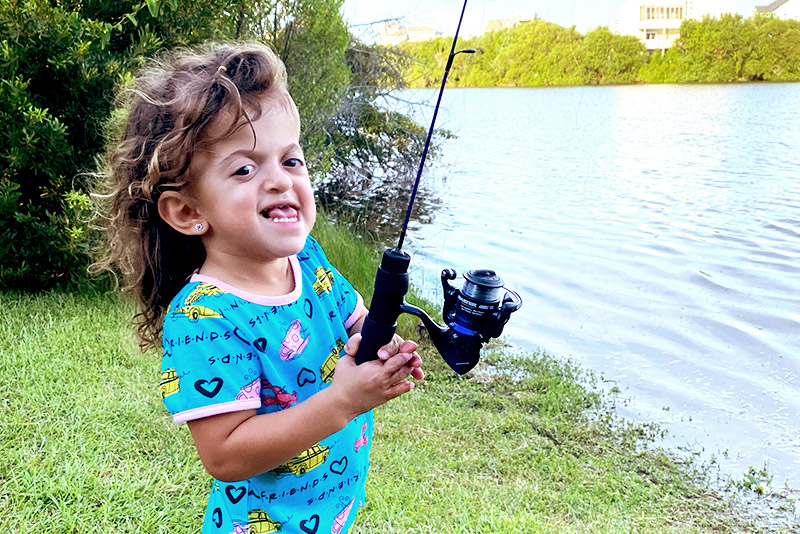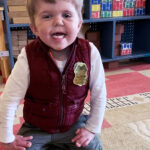Celebrating the unexpected, Miley’s family navigates Apert syndrome

Miley is the first girl born into her family in almost a generation. Hearing the delivery team announce, “It’s a girl,” is a moment her mom, Nicole, and her dad, Mike, will always remember.
“We just cried,” says Nicole. “I’ll never forget that moment.”
But what they also discovered at delivery was something else they weren’t expecting. Miley had webbed fingers and toes, a condition called syndactyly, and her skull looked large — a symptom of craniosynostosis, which is when the skull bones fuse too early.
“I noticed her hands and then her head,” Mike says of seeing his daughter for the first time. “Something was going on, but we didn’t know what.”
Finding expert care for Apert syndrome
Their work led them to the Cleft and Craniofacial Center at Boston Children’s Hospital, where they met Dr. Mark Proctor, Dr. John Meara, Dr. Brian Labow, and Dr. Amir Taghinia — surgeons who specialize in treating Apert syndrome, including syndactyly, craniosynostosis, and other craniofacial differences.
Because nothing was flagged during Nicole’s prenatal ultrasounds, everyone — including Nicole’s care team — was surprised by Miley’s webbed fingers and toes and atypical head shape. Within days, genetic testing confirmed Apert syndrome, a genetic disorder affecting skull, face, and limb development and characterized by fused fingers and toes. Nicole and Mike immediately went to work educating themselves about the condition and the best care options for Miley. This included reaching out to various hospitals, both in their home state of New York and across the country.
Boston Children’s approach to caring for Apert syndrome
Learn more about Apert syndrome and endoscopic strip craniectomy from the experts at Boston Children’s Hospital.
Nicole and Mike were reassured by how much experience the team had in caring for Apert syndrome in children and their innovative treatment methods. For example, while a common approach to treating craniosynostosis involves operating at the back of the skull to address excessive head growth, Boston Children’s uses a less invasive endoscopic release technique to separate the fused sutures at the front. This approach aims to create space for the brain to grow safely. Helmet therapy after the procedure helps support healthy head growth.
“Some of the doctors we saw said Miley would have been their first case treating Apert syndrome,” Nicole says. “But at Boston Children’s, this is what they see weekly. We wanted to go to the best of the best, and, in our eyes, they’re the best.”
“We really liked the idea of how the procedure was done,” Mike adds. “The endoscopic release sounded like a more of a proactive approach. So that was what attracted us to Boston Children’s.”
They also appreciated the team’s commitment to helping them fully understand Miley’s plan of care, including discussing how they’d work to fully separate her fused digits, giving her ten fingers and ten toes. Other centers they had met with looked to take a more conservative approach and leave some fingers and toes fused.
“They showed us images and models of skulls, hands, and feet and talked through what they would do during surgery,” Nicole says of the Boston Children’s team. Mike also found the team’s informational packet to be a helpful roadmap for understanding Apert syndrome care.
Boston or bust
In June 2020, at 10 weeks old, Miley came to Boston Children’s for endoscopic release surgery. She returned at 9 and 14 months old for syndactyly releases to separate the soft tissue and ligaments between her fingers. She came back last summer for fronto-orbital advancement, a surgical procedure that reshapes and repositions the forehead and eye socket bones. For Nicole and Mike, the care Miley receives is worth every second of the five-hour drive to Boston.
“I tell people, nothing compares to Boston Children’s,” Nicole says. “The nurses and doctors make you feel like there’s only you there, and they’re caring for whatever you need. They just make you feel so much better about everything.”
Cherishing everything Miley
Today, Nicole and Mike are treasuring everything that makes Miley, Miley.
“She’s a typical 3-year-old,” says Nicole. “She loves her older brother. She loves the playground. She loves the pool. She’s in the game. She’s right up in there playing sports with everybody else.”
“I love to talk about who she is first,” Nicole adds. “Because she’s not defined by her syndrome. She’s the light of the day. We’re just so proud of everything she’s accomplished so far.”
Learn more Apert syndrome and the Cleft and Craniofacial Center at Boston Children’s Hospital.
Related Posts :
-

Sonny’s story: How an online Apert syndrome community set one family on a path to Boston
Sonny Daniel has had a busy summer. Between traveling, camp, and time with family and friends, this 4-year-old has constantly ...
-

Pieces at work: Luca’s experience with Apert syndrome
Luca Paolacci, 24, is pursuing his bachelor's degree in mechanical engineering. It's a serendipitous major given that it studies how pieces ...
-

Weathering the storm of Apert syndrome: João’s story
After a “perfect” pregnancy in 2017, Natalia and Igor of Brazil were excited to meet their third child. They were shocked ...
-

Superando as dificuldades da síndrome de Apert: a história do João
Depois de uma gravidez “perfeita” em 2017, os brasileiros Natália e Igor estavam emocionados por conhecer seu terceiro filho. Eles ...





